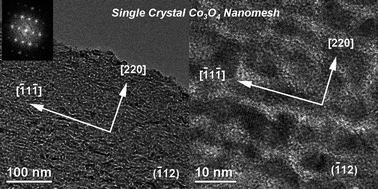In this article, we introduce a novel two-dimensional (2D) functional Co3O4 nanostructure, “nanomesh”, which possesses the highest surface area (382 m2 g−1) as compared to the other Co3O4 nanostructures, well-crystallized features, thickness of no more than 10 nm and a void space diameter below 6.0 nm. These structural characteristics of the nanomesh are well-suited for lithium-ion battery (LIBs) applications. In initial tests, high specific capacity (1800 mAh/g), good rate capability (above 380 mAh/g at a discharging rate of 1000 mA g−1 over 50 cycles) and stable cyclability (up to 100 cycles) have been demonstrated. In addition, the dominant (![[1 with combining macron]](https://www.rsc.org/images/entities/char_0031_0304.gif) 12) crystal plane in the nanomesh has much higher surface energy than the conventional (111) and (100) crystal planes, leading to higher activity in supercapacitors. The Co3O4 nanomesh demonstrated in this research could be successfully utilized in energy and environmental applications, such as selective catalysis, gene delivery and gas or biological sensing, besides the application in electrochemical energy storage shown in this work. More importantly, the synthesis strategy used in this research can possibly be extended to other material systems as a general approach to fabricate 2D mesoporous oxides.
12) crystal plane in the nanomesh has much higher surface energy than the conventional (111) and (100) crystal planes, leading to higher activity in supercapacitors. The Co3O4 nanomesh demonstrated in this research could be successfully utilized in energy and environmental applications, such as selective catalysis, gene delivery and gas or biological sensing, besides the application in electrochemical energy storage shown in this work. More importantly, the synthesis strategy used in this research can possibly be extended to other material systems as a general approach to fabricate 2D mesoporous oxides.

You have access to this article
 Please wait while we load your content...
Something went wrong. Try again?
Please wait while we load your content...
Something went wrong. Try again?
![[1 with combining macron]](https://www.rsc.org/images/entities/char_0031_0304.gif) 12) crystal plane in the nanomesh has much higher surface energy than the conventional (111) and (100) crystal planes, leading to higher activity in supercapacitors. The
12) crystal plane in the nanomesh has much higher surface energy than the conventional (111) and (100) crystal planes, leading to higher activity in supercapacitors. The 

 Please wait while we load your content...
Please wait while we load your content...